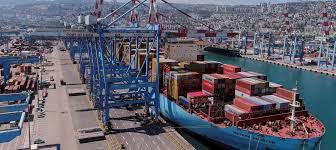
India is poised to enter the global container ship industry with the inauguration of the Vizhinjam transshipment container port, developed by Adani Ports and SEZ Ltd. in collaboration with the local state government. Located near the southernmost tip of the country, the Vizhinjam port, set to be inaugurated on October 15, will allow India to claim a larger share of international maritime trade. This move is expected to bolster India’s ambitions to be an alternative manufacturing hub by reducing logistics costs for cargo transportation.
The Vizhinjam port, a deep-sea port along Kerala’s picturesque coastline, is Adani’s latest ambitious infrastructure project. The port’s strategic location near international shipping routes, which account for 30% of global cargo traffic, makes it an ideal hub for some of the world’s largest container ships. Until now, these giant vessels have been bypassing India because its harbors lacked the necessary depth to accommodate them. As a result, they often docked at neighboring ports such as Colombo, Dubai, and Singapore.
Transshipment, the process of transferring cargo from one ship to another, typically larger vessel at a port along the way to its final destination, is essential for efficient international cargo shipping. The Vizhinjam port, with its deeper channels and advanced infrastructure, will facilitate this process, potentially attracting giant container ships and improving cargo transit between India and the world.
The Vizhinjam port is expected to become a game-changer for India’s shipping industry and improve the country’s standing in international maritime trade. India’s container traffic is significantly lower than that of China, with just 17 million TEUs in 2020 compared to China’s 245 million TEUs. This massive project is part of the Indian government’s plans to develop world-class mega ports and transshipment hubs, with an estimated investment of 1.25 trillion rupees ($15 billion), as outlined in the Maritime India Vision 2030.
The Vizhinjam port is set to offer quick vessel turnaround, including Megamax container ships, with a capacity of 1 million TEUs in the first phase. Subsequent phases are planned to add around 6.2 million TEUs. Although the project has faced some challenges, including protests by local fishermen, it remains a significant milestone in India’s infrastructure development.
The federal government’s Maritime India Vision 2030 aims to modernize India’s ports and develop strategic mega ports and transshipment hubs with a total investment of 1.25 trillion rupees. With large ships becoming increasingly vital for trade between Europe and China, India’s strategic location between the Suez Canal and the Strait of Malacca positions it to play a more substantial role in global maritime trade.
The Vizhinjam port’s inauguration is a pivotal moment in India’s quest to enhance its presence in the international shipping industry and further establish Adani Ports as a prominent player in the nation’s infrastructure landscape.
Sources By Agencies




